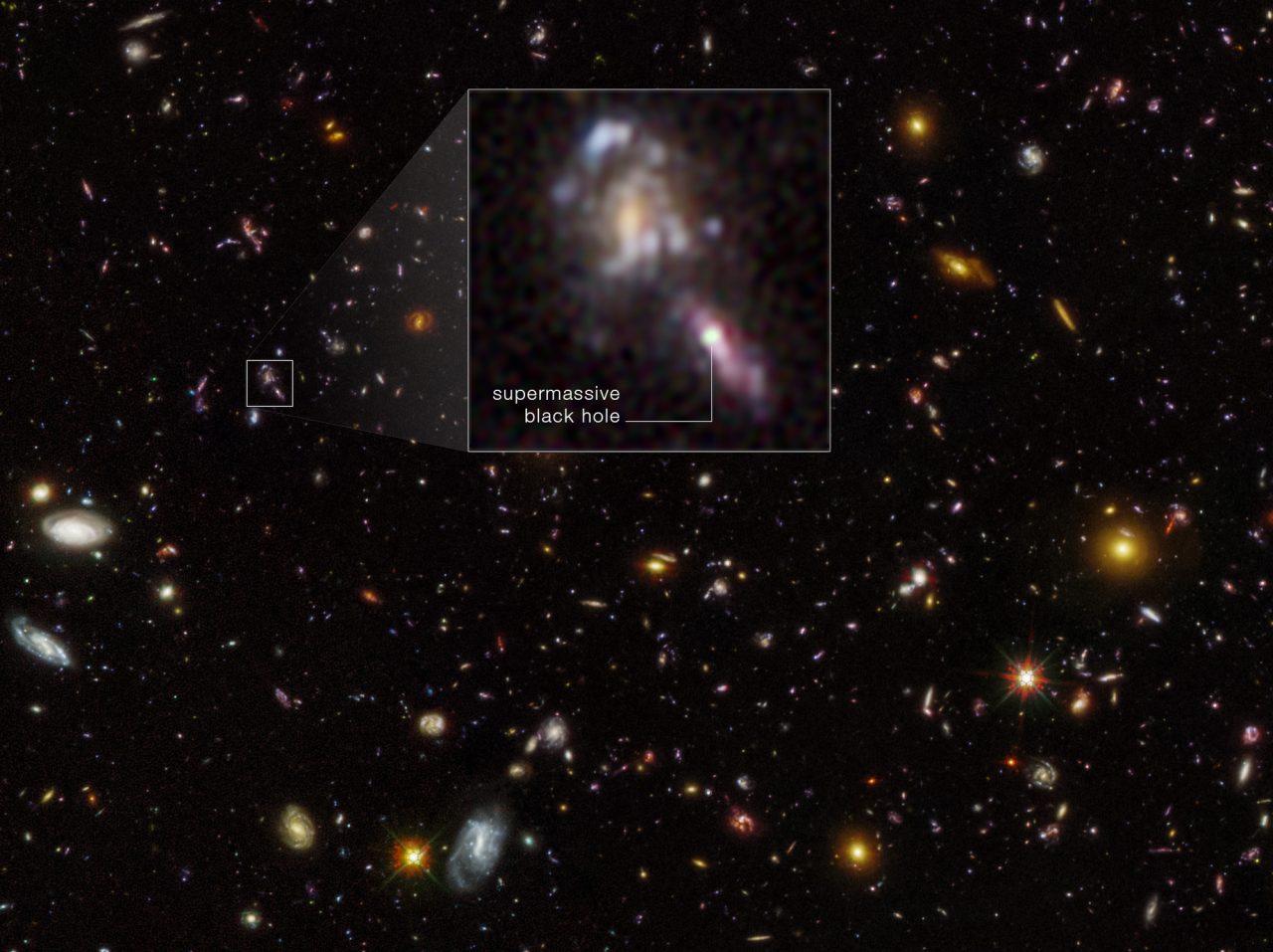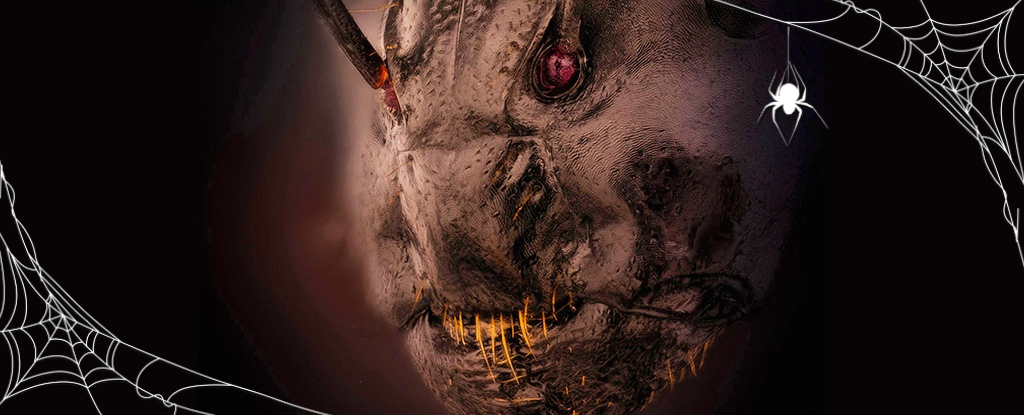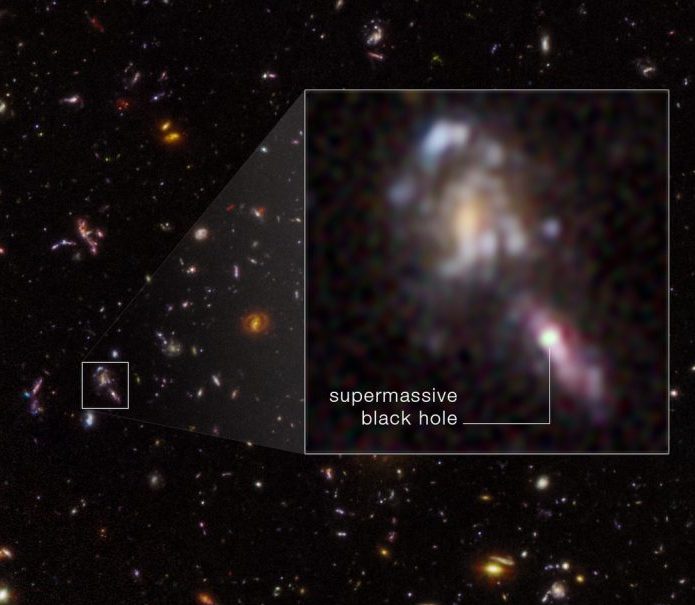This is a zoomed-in image of a pair of galaxies observed by the Hubble Ultra Deep Field (HUDF) in the corner of the constellation Fornax.

The focus is on the active galactic nucleus (Active Galactic Nucleus: AGN) is a brightness that indicates the presence of supermassive black holes (supermassive) with masses millions to billions of times greater than the mass of the Sun. What is an active galactic nucleus?Strong electromagnetic waves are emitted.Galaxy CenterIt is a narrow region where powerful electromagnetic waves such as visible light and X-rays are believed to be emitted from the high-temperature accretion disk that forms when matter is drawn into the black hole in a spiral pattern.
The Hubble Ultra Deep Field is about 3 arcminutes across (about the diameter of the full Moon), and was observed by the Hubble Space Telescope (HST) of the National Aeronautics and Space Administration (NASA) and the European Space Agency (ESA) (approximately 1/10) of the region. The first observations, made from September 2003 to January 2004, took a total exposure time of 11.3 days and captured about 10,000 galaxies that existed from about 13 billion to 1 billion years ago. The Hubble Space Telescope will continue to observe the same region multiple times through 2023.
To better understand the relationship between the evolution of galaxies and black holes, a research team led by Matthew Hayes of Stockholm University used data from the Hubble Ultra Deep Field, which has been repeatedly observed in the early universe, to analyze a supermassive black hole present in the galaxy.
According to the Space Telescope Science Institute (STScI), which operates the Hubble Space Telescope, black holes intermittently absorb the matter around them, so the brightness of active galactic nuclei, driven by black hole activity, will flash. By comparing Hubble's Ultra Deep Field observation data obtained over several years, researchers hope to detect changes in the brightness of galaxies and indirectly find black holes.
As a result of the analysis, the research team found that there were many more supermassive black holes in the early universe than previously reported. The active galactic nucleus shown in the opening image is an example of a supermassive black hole discovered in this study, and is thought to have existed in the universe about 10.4 billion years ago (redshift z = 2).
Supermassive black holes are thought to have already existed in some galaxies less than a billion years after the Big Bang, about 13.8 billion years ago, but the shapes of supermassive black holes are still not clearly understood.
New observations from the Hubble Space Telescope show that some of these stars were formed by the collapse of the first massive stars that existed only in the early universe within a billion years of the Big Bang, suggesting that black holes may have formed by becoming “seeds.”
Other possibilities for the birth of black holes, which become the “seeds” that grow into supermassive black holes, include the direct collapse of gas clouds. The new information about black hole formation in the early universe provided by this study is expected to lead to more accurate models of galaxy formation.
The image was initially released by STScI, NASA, and ESA on September 17, 2024. Additionally, a paper summarizing the research team's findings was published in The Astrophysical Journal Letters.
source
- Space Science Institute NASA's Hubble Telescope Discovers More Black Holes Than Expected in Early Universe
- NASA NASA's Hubble Telescope Discovers More Black Holes Than Expected in Early Universe
- European Space Agency/Hubble Hubble Discovers More Black Holes Than Expected in Early Universe
- Hayes et al. – Flashes in the Cosmic Dawn: A Census of the Smallest Supermassive Black Holes by Photometric Variation (The Astrophysical Journal Letters)
Editorial Department/Editorial/Syrian

“Travel maven. Beer expert. Subtly charming alcohol fan. Internet junkie. Avid bacon scholar.”







More Stories
Call of Duty: Black Ops 6 has released a trailer for the remastered version of the Nuketown map. Infected mode arrives today
What titles do you recommend for players who have never experienced the Golden Age of PlayStation 2? Introducing the games that experts love |.Game*Spark – the local and international gaming information site
CEO/Director of Sandbox ADV “Core Keeper,” which is selling well in Japan, asks for “ideas for communicating community love” in Japanese